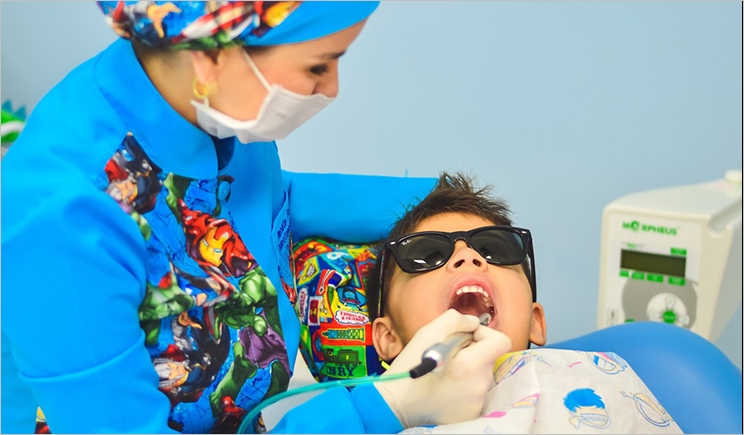
February is National Children’s Dental Health Month (NCDHM). For some kids and their families, this is their best shot at access to dental care. Many still face low Medicaid reimbursement, reluctance of some dentists to see young children, and pervasive oral health illiteracy, adding to many other struggles of daily life that keep them from care.
Confronting these issues is the substance of oral health policy for children in our country. NCDHM events around the United States match children and families with care sources. Perhaps unknown to many, even in our own profession, they also address important policy gaps affecting pediatric oral health.
The American Academy of Pediatric Dentistry (AAPD) is a strong supporter of NCDHM for the care it delivers, but also because it contributes important metrics indicative of oral health, fosters access to care in novel ways, and engages communities outside of dentistry to create awareness and facilitate care. The Pediatric Oral Health Research and Policy Center (POHRPC) is AAPD’s extension into policy issues overlying access to oral health care, and we value NCDHM’s input into important policy areas that traditional care programs and practices may not reach.
Most of us tend to view NCDHM only through the care delivered to individual children during the event, but we shouldn’t lose sight of its combined contribution across the country in important policy areas. For example, AAPD, like most of dentistry, has embraced evidence-based dentistry. As a result, it supports measures of utilization developed by the Dental Quality Alliance (DQA) as primary measures of utilization.
NCDHM adds to the primary metrics of “any dental visit for prevention” or “any dental visit with a treatment service” and “any dental sealant applied to permanent molars” in a big way at its events across the nation, with tens of thousands of encounters. Dental sealants in particular abound in NCDHM programs, and both the DQA and our nation’s Healthy People Goals hold sealant application key to the oral health of children.
Another of AAPD’s priorities is efficiency in care delivery by spreading resources where needed. A recent brief by the POHRPC encourages caries risk assessment for all children. NCDHM occurs just once a year, but in that encounter, children receive other necessary services and preventive instruction, and the oral health illiteracy of families is chipped away, based on their individual need. Proponents of basic health care systems that use risk to assign further care should also be pleased that the Give Kids a Smile (GKAS) movement sorts kids and refers them to sources of care as a part of many GKAS activities in the nation’s mosaic.
One of AAPD’s primary policy goals is the placement of children in a dental home, preferably early in life. Many NCDHM programs try to link children and families to a permanent dental home. We would be naïve to underestimate the push toward dental homes that emerges from GKAS activities to willing offices, clinics, dental schools, and federally qualified health centers. These dental homes are those willing to care for children irrespective of ability to pay, offices that accept Medicaid, or facilities that are able to secure Medicaid funding to help families.
The dental community gets a closer look at the needs of kids they might not see. In caring for them, dental professionals better understand access issues, negative social determinants of health, and oral health illiteracy. These activities can change professional lives and often do. For some dentists, these efforts carry over to their practices in a willingness to see children and then to engage in advocacy for pediatric oral health, the primary mission of AAPD. We can’t underestimate the effect of NCDHM on building the power of advocacy!
NCDHM activity in February has spawned continued efforts in many communities to replicate “days” in other months and places. In my own community, GKAS activity led to the involvement of dental society members in continuing Head Start screenings, free clinics, and other “care-extenders” over the year. It’s not uncommon for these continued activities to unite community dental professional organizations with child advocacy groups, school systems, and social service agencies. That “first date” during NCDHM can lead to sustained activity and an increased awareness among non-dentists of the value of oral health.
From a policy perspective, this continuing collaborative effort satisfies the goal of a more sustainable broadened oral healthcare system for children. It should not be surprising that national efforts like NCDHM—for example, Bright Futures, our national health supervision guidelines, and the inclusion of pediatric oral health care as an essential health benefit in the Affordable Care Act—have contributed to policy change.
Finally, as AAPD looks forward at a changing pediatric oral health landscape, its policy center will weigh the effects of NCDHM in getting “children in chairs,” learn from its successes, and continue to support this important activity. AAPD’s workforce initiatives, investment in children’s health coverage programs, promotion of general dentists’ care of children, and dental home promotion are closely tied to NCDHM, and we applaud the efforts of those working to improve pediatric oral health.
Dr. Casamassimo is the chief policy officer at the AAPD Pediatric Oral Health Research and Policy Center. He received his dental degree from Georgetown University and a Master of Science and Certificate in Pediatric Dentistry from the University of Iowa. He is former editor-in-chief of the AAPD and its journal, Pediatric Dentistry, and also a past-president of AAPD. Dr. Casamassimo is past-president of the Academy of Dentistry for the Handicapped and past editor of the Journal of Dentistry for the Handicapped and the Journal of Dentistry for Children. He is board-certified in pediatric dentistry and practices at Nationwide Children’s Hospital in Columbus, Ohio. He can be reached at Paul.Casamassimo@nationwidechildrens.org.
Related Articles
Dental Practices Needed for Annual Smile Drive
ADA Foundation Names 2018 GKAS Grant Recipients
$1.53 Million Grant Expands Pediatric Dentistry Training











